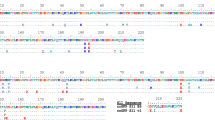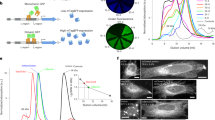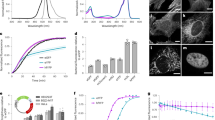Abstract
We report a monomeric yellow-green fluorescent protein, mNeonGreen, derived from a tetrameric fluorescent protein from the cephalochordate Branchiostoma lanceolatum. mNeonGreen is the brightest monomeric green or yellow fluorescent protein yet described to our knowledge, performs exceptionally well as a fusion tag for traditional imaging as well as stochastic single-molecule superresolution imaging and is an excellent fluorescence resonance energy transfer (FRET) acceptor for the newest cyan fluorescent proteins.
This is a preview of subscription content, access via your institution
Access options
Subscribe to this journal
Receive 12 print issues and online access
$259.00 per year
only $21.58 per issue
Buy this article
- Purchase on Springer Link
- Instant access to full article PDF
Prices may be subject to local taxes which are calculated during checkout

Similar content being viewed by others
Accession codes
Primary accessions
NCBI Reference Sequence
Referenced accessions
NCBI Reference Sequence
Protein Data Bank
References
Tsien, R.Y. Annu. Rev. Biochem. 67, 509–544 (1998).
Shaner, N.C., Patterson, G.H. & Davidson, M.W. J. Cell Sci. 120, 4247–4260 (2007).
Goedhart, J. et al. Nat. Commun. 3, 751 (2012).
Markwardt, M.L. et al. PLoS ONE 6, e17896 (2011).
Goedhart, J. et al. Nat. Methods 7, 137–139 (2010).
Miyawaki, A. Annu. Rev. Biochem. 80, 357–373 (2011).
Lam, A.J. et al. Nat. Methods 9, 1005–1012 (2012).
Campbell, R.E. et al. Proc. Natl. Acad. Sci. USA 99, 7877–7882 (2002).
Shaner, N.C. et al. Nat. Biotechnol. 22, 1567–1572 (2004).
Shaner, N.C. et al. Nat. Methods 5, 545–551 (2008).
Roy, A., Kucukural, A. & Zhang, Y. Nat. Protoc. 5, 725–738 (2010).
Lyskov, S. & Gray, J.J. Nucleic Acids Res. 36, W233–W238 (2008).
Nagai, T. et al. Nat. Biotechnol. 20, 87–90 (2002).
Li, G., Zhang, Q.-J., Zhong, J. & Wang, Y.-Q. Gene 446, 41–49 (2009).
Ai, H.-W., Olenych, S.G., Wong, P., Davidson, M.W. & Campbell, R.E. BMC Biol. 6, 13 (2008).
Karasawa, S., Araki, T., Yamamoto-Hino, M. & Miyawaki, A. J. Biol. Chem. 278, 34167–34171 (2003).
Malo, G.D. et al. J. Mol. Biol. 378, 871–886 (2008).
Yarbrough, D., Wachter, R.M., Kallio, K., Matz, M.V. & Remington, S.J. Proc. Natl. Acad. Sci. USA 98, 462–467 (2001).
Magde, D., Wong, R. & Seybold, P.G. Photochem. Photobiol. 75, 327–334 (2002).
Gross, L.A., Baird, G.S., Hoffman, R.C., Baldridge, K.K. & Tsien, R.Y. Proc. Natl. Acad. Sci. USA 97, 11990–11995 (2000).
Chalfie, M. & Kain, S.R. Green Fluorescent Protein: Properties, Applications, and Protocols (Wiley-Interscience, 2006).
Shaner, N.C., Steinbach, P.A. & Tsien, R.Y. Nat. Methods 2, 905–909 (2005).
Subach, O.M., Cranfill, P.J., Davidson, M.W. & Verkhusha, V.V. PLoS ONE 6, e28674 (2011).
Sun, Y., Day, R.N. & Periasamy, A. Nat. Protoc. 6, 1324–1340 (2011).
Colyer, R.A., Lee, C. & Gratton, E. Microsc. Res. Tech. 71, 201–213 (2008).
Redford, G.I. & Clegg, R.M. J. Fluoresc. 15, 805–815 (2005).
Snapp, E.L. et al. J. Cell Biol. 163, 257–269 (2003).
Costantini, L.M., Fossati, M., Francolini, M. & Snapp, E.L. Traffic 13, 643–649 (2012).
Acknowledgements
We thank S.H. Haddock for the use of his lab's Shimadzu ultra-high-performance liquid chromatography instrument, W.R. Francis for help in compiling data, and S.G. Gilbert, C.K. Malik and R.A. Evans for their helpful contributions.
Author information
Authors and Affiliations
Contributions
M.I. cloned the original gene encoding LanYFP from B. lanceolatum, performed initial characterization of the protein, and identified the substitutions I118K (dimerizing) and N174T (folding enhancement). G.G.L. performed the majority of library construction, E. coli expression experiments, and protein purification. A.C., J.W. and Y.N. performed initial cloning and library construction for screening dimeric variants. R.N.D. performed FLIM-FRET experiments. J.R.A. performed single-molecule superresolution imaging experiments. M.W.D., P.J.C., M.A.B. and B.R.S. constructed mammalian expression and fusion plasmids, performed fixed- and live-cell imaging and FRET experiments, and helped write the manuscript. J.W. contributed to writing and editing the manuscript and supported the project. N.C.S. designed and planned the project, performed library design and screening, optical characterization and size-exclusion experiments, and wrote the manuscript.
Corresponding author
Ethics declarations
Competing interests
M.I. is affiliated with Innoventus (Uppsala, Sweden), which administers patent licensing for the original LanYFP clone. N.C.S., A.C., Y.N. and J.W. are affiliated with Allele Biotechnology and Pharmaceuticals, Inc., which holds an exclusive license to LanYFP from Innoventus. Allele has filed for patent protection of mNeonGreen. The Scintillon Institute is a nonprofit research institute funded in part by Allele.
Supplementary information
Supplementary Text and Figures
Supplementary Figures 1–16, Supplementary Tables 1–3, Supplementary Discussion (PDF 43094 kb)
Supplementary Data 1
PDB structure file of I-TASSER and RosettaDock generated model of LanYFP A/B dimer. (TXT 619 kb)
Supplementary Data 2
PDB structure file of I-TASSER and RosettaDock generated model of LanYFP A/C dimer. (TXT 618 kb)
Supplementary Table 4
Primers used in this study. (XLS 19 kb)
Rights and permissions
About this article
Cite this article
Shaner, N., Lambert, G., Chammas, A. et al. A bright monomeric green fluorescent protein derived from Branchiostoma lanceolatum. Nat Methods 10, 407–409 (2013). https://doi.org/10.1038/nmeth.2413
Received:
Accepted:
Published:
Issue Date:
DOI: https://doi.org/10.1038/nmeth.2413
This article is cited by
-
Bright and stable monomeric green fluorescent protein derived from StayGold
Nature Methods (2024)
-
Structural biases in disordered proteins are prevalent in the cell
Nature Structural & Molecular Biology (2024)
-
StayGold variants for molecular fusion and membrane-targeting applications
Nature Methods (2024)
-
A prime editor mouse to model a broad spectrum of somatic mutations in vivo
Nature Biotechnology (2024)
-
γ-2 and GSG1L bind with comparable affinities to the tetrameric GluA1 core
Cellular & Molecular Biology Letters (2023)



